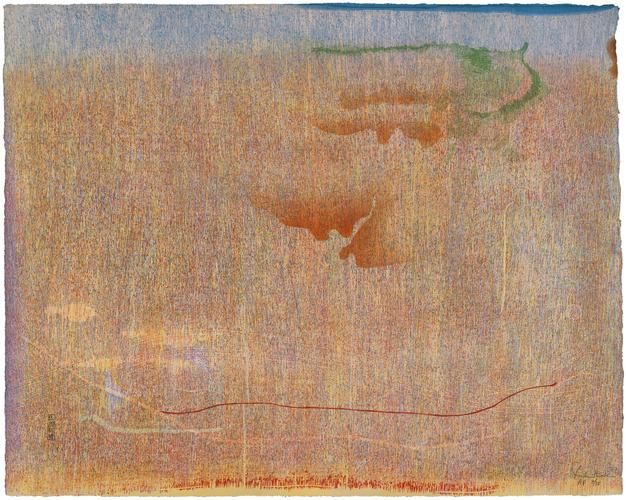Helen Frankenthaler
Born in 1928, Helen Frankenthaler was an influential and experimental painter. After seeing a Jackson Pollock exhibition when she was 22, Frankenthaler found her style and started pouring turpentine-thinned oil paints directly on raw canvas. This innovative staining technique inspired many artists of what became known as the Color Field movement. Frankenthaler, a New York native, was the youngest daughter of a New York Supreme Court judge, Alfred Frankenthaler. She grew up cultured and privileged, encouraged academically and artistically to pursue a professional career. This was a revolutionary idea for the time.
Frankenthaler studied at the Dalton School and then at Bennington College. Her first success came in 1952 with the enormous painting Mountains and Sea, which debuted her oil-stain technique. Frankenthaler’s canvases are complex and simple at the same time, with layered translucent paints creating texture and shape that emphasize the two-dimensional aspect of the canvas.
Also a gifted printmaker, Frankenthaler created an etching titled Nepenthe at Crown Point Press in 1972. It was published by the John Berggruen Gallery in San Francisco. In 1983, Frankenthaler travelled to Kyoto, Japan to print and publish Cedar Hill with Crown Point Press. Cedar Hill is different from her other prints because it was the first time she used water-based ink as opposed to the Western oil-based ink. Frankenthaler created many woodcuts, including a series of prints published by Tyler Graphics titled Tales of Genji (1998) after Murasaki Shikibu’s 11th century novel. The six-piece series took three years to complete because Frankenthaler first painted each image. Then multiple blocks were cut to separate colors and shapes, and finally the blocks were inked using water-based ink and printed on handmade cotton paper. The third work in the series uses 53 colors on 18 blocks. Like her paintings, Frankenthaler’s prints emphasize color and texture.
Though she was among only a few female artists in her time, Frankenthaler resisted being labeled by her gender and wanted to be remembered for her talent and innovation. She was always experimenting to find new modes of expression and believed this was essential to the creative process. In an interview with Tyler Graphics in 1994, Frankenthaler said, “There are no rules…That is how art is born, how breakthroughs happen. Go against the rules or ignore the rules. That is what invention is about.”
Helen Frankenthaler died in 2011 from a long-term illness. She was married twice, to fellow painter Robert Motherwell from 1958 until 1971, and then to investment banker Stephen M. DuBrul, Jr. in 1994.
Frankenthaler’s first solo exhibition was in 1951 at the Tibor de Nagy Gallery in New York. Her first retrospective was in 1960 at the Jewish Museum, also in New York. Museums across the country have exhibited her work, including the Guggenheim Museum in New York City; the Los Angeles County Museum of Art in Los Angeles, CA; National Gallery of Art in Washington, DC; the Savannah College of Art and Design in Savannah, GA; and the National Gallery of Australia. She was awarded the National Medal of Arts in 2002 and served as a council member at the National Endowment for the Arts from 1985 to 1992.
-Hana Haber, Crown Point Press
THIRTY-FIVE YEARS AT CROWN POINT PRESS: MAKING PRINTS, DOING ART
